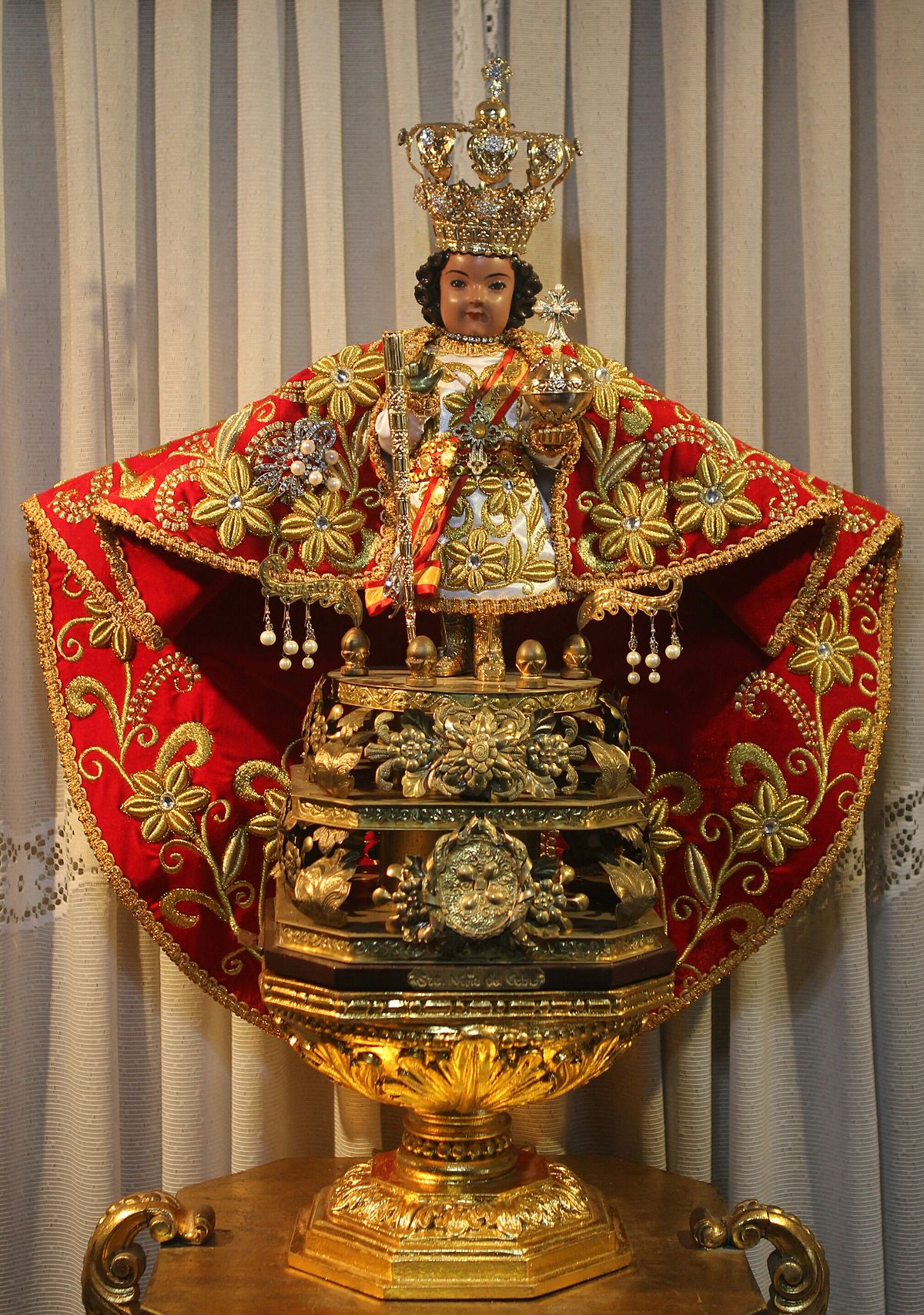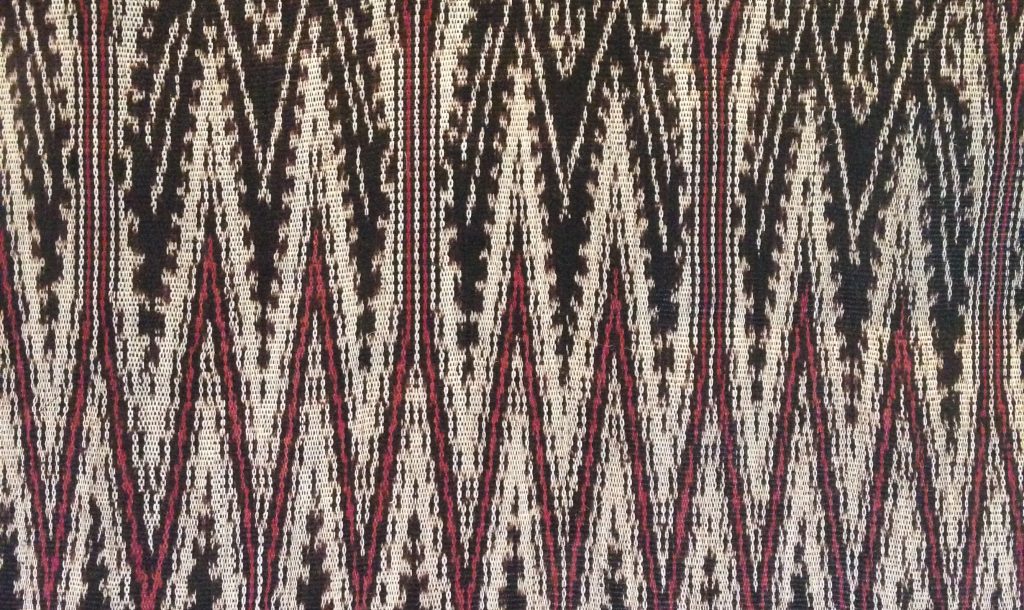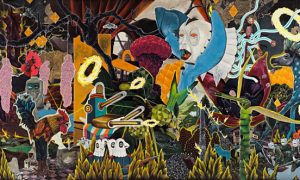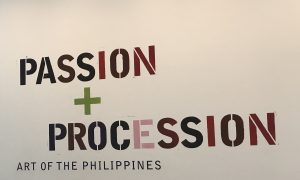In this experiment, four members of Perspectives of the Past visit the Art Gallery of New South Wales (AGNSW) for Passion + Procession: Art of the Philippines and write four mini-reviews about their experience based on their diverse backgrounds (museum and heritage studies, performance studies, history and archaeology).
Today’s review focuses on the historical contexts of the artworks in the exhibition. It tries to show how familiar features of modern Philippine art and culture can have unexpected historical resonances and nuances.
Do You Have A Place In Southeast Asia, Pedro?

Rodel Tapaya (2015-16) Adda Manok Mo, Pedro? (Photo: W.J. Sastrawan)
As I entered the Art Gallery of New South Wales’ Passion + Procession: art of the Philippines exhibition space, I was struck by a vast acrylic painting by Rodel Tapaya, depicting warfare, halos of fire, Illuminati-like pyramids and diamonds, and a lot of chickens. This surreal and rather comical montage had a serious message about the daily presence of violence in Philippine life, drawing particular attention to recent battles between national security forces and Muslim militants on the island of Mindanao in the nation’s south. The caption described the painting’s imagery as being “drawn from Catholicism and pre-colonial folklore”.
But as I kept looking, the artwork’s symbolism seemed more generally Southeast Asian and less specifically Filipino. There were all kinds of connections to other cultures in the region that went unmentioned in the artwork’s caption. For example, the Ilocano title of the work, “Adda manok mo, Pedro?” (Do you have a rooster, Pedro?), sounded to me like a mixture of Malay (ada = “there is”, -mu = “your”) and Javanese (manuk = “bird”, “cock”). The symbolism of the rooster as an agent of male power and violence is well-known in Indonesia by the term jago, which connotes “champion” but also “gangster”.
From datus to trapos: reading Philippine history in the OED
How an English dictionary documents different eras of linguistic exchange between Filipinos and their colonisers.

The last page of a four-page letter in the Maguindanao language in Arabic script, from Sultan Muhammad Syah Amiruddin of Maguindanao, 1746, held by the British Library and available online. (Photo: British Library / Public Domain)
Muslim influences are also present in Philippine culture. The island of Mindanao, whose security problems Tapaya’s painting alludes to, shares a great deal of its cultural heritage with nearby Malay societies. This common Muslim heritage is exemplified by the various sultanates that thrived in the southern islands from the 15th to the 18th centuries as classic Malay entrepôt states, on par with the older palaces of Brunei and Johor.
Mindanao historical traditions claim that Islam came to the Philippines through high-born missionaries from the Malay peninsula, Sumatra and Borneo. While it is difficult to verify the details of the biographies of individual missionaries, it is probably true that Malay clerics were crucial to the conversion of southern Filipinos to Islam. Memories of this historical Filipino-Malay solidarity against European colonialism are preserved to this day by Muslim separatists who have taken up arms against the Philippine state.
But the caption of “Adda manok mo, Pedro?” made no mention of any of these regional links, instead describing all of the Southeast Asian images and references as indigenous “Philippine folk mythologies”. I was disappointed to find that as I made my way around the exhibition, the cultural connections between the Philippines and the rest of Southeast Asia kept being downplayed, in favour of an emphasis on the national distinctiveness of Philippine art and the predominant role of Catholicism within that art.
Devout Colonialism
One of the most famous symbols of Catholic devotion in the Philippines, the Child Jesus of Cebu, was alluded to by a work in the exhibition. This venerated relic is associated with the very earliest stage of Spanish Catholic colonisation of the Philippines.

The Child Jesus of Cebu statue, venerated in the Minor Basilica of Santo Niño, Cebu City (Photo: Ellis Mendez 2006 / CC License)
The Child Jesus statue was brought to the Philippines in the 16th century by the explorer Ferdinand Magellan, a Portuguese in the service of the Spanish crown who was looking for a Pacific ocean route to the Indonesian Spice Islands. On 14 April 1521, Magellan gave the statue to the indigenous rulers of Cebu, Raja Humabon and his chief consort Hara Humamay, who had both just converted to Catholicism. The Child Jesus therefore marks the first Christian conversion of historical significance in the Philippines.
But Spanish colonisation did not properly begin until the arrival of Miguel Lopez de Legazpi in 1565. This time around, the new king of Cebù did not want to convert to Christianity or accept Spanish rule, so Legazpi attacked and deposed him. In the ruins of Cebu’s former capital, one of Legazpi’s mariners discovered the original Child Jesus statue gifted by Magellan 44 years before. The survival of the relic, amongst the destruction of the indigenous kingdom, was seen as miraculous proof that God was on the side of the Spanish campaign. Now enshrined behind bulletproof glass in Cebu City, the Child Jesus icon represents an originary moment for both Catholicism and colonialism in the Philippines.
In the Passion + Procession exhibition, this relic was replicated by Renato Habulan as one of a series of ten wooden sculptures that depict the Catholic and indigenous inflections in Filipino religiosity. What was notable about the inclusion of the Child Jesus in Habulan’s self-consciously folksy artwork, is that it showed how the social resonance of this relic has changed drastically since the 16th century. Originally a royal gift and miraculous talisman for the deeply statist Spanish colonial project, the statue is now beloved as an object of popular devotion by the citizens of an independent, postcolonial republic. Unfortunately the exhibition did not provide the necessary historical information to bring that remarkable transformation to viewers’ attention.
Mixed Religion, Mixed History
Habulan’s claim that “religious practice in the Philippines is mixed” was a central thesis of the whole exhibition. But the exhibition seemed imply that the mixture consisted of two ingredients only: organised Catholic religion and indigenous folk spirituality. This conceptual binary was repeated in many of the artwork captions, and it left little room for a couple of issues that I felt deserved more attention.

The exhibition’s Mindanao ikat textiles shows remarkable similarities, in terms of production and design, to Malay and Indonesian weaving. (Photo: W.J. Sastrawan)
The first issue was about the historical links between the Philippines and other parts of Southeast Asia, and especially between Muslim communities whose traditional networks transcended national borders. Those relationships tended to be obscured in this exhibition, both by the repetition of the Catholic/folk binary and also by the emphasis on the indigenous aspects in the artworks. Symbols and concepts of regional significance were presented as if they derived from purely local mythologies.
On the only panel where the Philippines’ cultural links with its neighbours were acknowledged, it was in very abstract terms of “share[d] cultural and religious practises” and “exchange between the region’s diverse communities”. Without specific examples of those shared practices and exchanges, it was difficult to see how the Filipino artists were participating in, and responding to, the general currents of Southeast Asian history and culture.
The second issue was about the relationship between Christianity and colonialism. Talk of “mixed” or “fused” religiosity often glossed over the political character of Catholic presence in the Philippines. Proselytising was the primary reason and justification for Spanish colonisation of the archipelago, as expressed in a 1591 contract authorising an attempted conquest of Mindanao for God and King:
“the most worthy and important thing in these islands [is] to strive for the propagation of our holy faith among the natives herein, their conversion to the knowledge of the true God, and their reduction to the obedience of His holy church and of the king, our sovereign”
Governor Gomez Peres Dasmariñas, Manila, 12 May 1591
(quoted from the sourcebook Mindanao Muslim History)
Miraculous relics such as the Child Jesus of Cebu were crucial to the task of establishing a Catholic colony, both by strengthening the faith of the colonists and by persuading native converts of the supremacy of the Christian God. By neglecting to mention how the biographies of this devotional object was tied up with colonial politics, the exhibition missed an opportunity to place modern religious practice in the context of the nation’s colonial past.
Southeast Asian history, Catholic history, Muslim history, and colonial history are all mixed up in Philippine history, and they have all left their mark on Filipino culture and art. By engaging with the historical complexities of the contemporary artworks exhibited in Passion + Procession, we can better understand the artistic achievement they embody.
 Facebook
Facebook  Twitter
Twitter  Soundcloud
Soundcloud  Youtube
Youtube  Rss
Rss 



